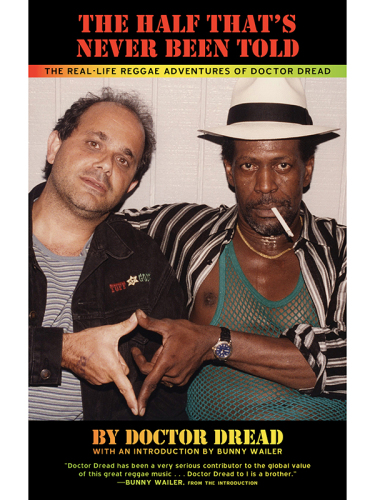
The Half That's Never Been Told
The Real-Life Reggae Adventures of Doctor Dread
کتاب های مرتبط
- اطلاعات
- نقد و بررسی
- دیدگاه کاربران
نقد و بررسی

March 23, 2015
In 1972, Gary Himelfarb, a somewhat aimless stoner kid from the Washington, D.C., suburbs, heard reggae music for the first time and fell in love. He embraced the music of the landmark film The Harder They Come and the records of Bob Marley with a passion that he matched with a genuine curiosity about Jamaican culture and sincere friendships with musicians there. This scattered autobiography traces Doctor Dread's unlikely and sometimes uninteresting journey through the reggae music business in a meandering manner, with long digressions about teenage drug adventures in South America, and frequent exultations of the Rastafarian faith. There is a sweetness and sincerity to the best parts of the book, such the story of how he founded Real Authentic Sounds (RAS), which became the foremost distributor of roots-style reggae in the U.S. as well as an independent record label. But apart from a bit of the charge and zest of working with small independent recording companies in an era of major labels and music conglomerates, there's little about the actual music business, and most of his insider anecdotes will appeal only to dedicated fans of old-school, Rasta-laced reggae. While Dread did succeed in spreading the words and music of Bob Marley, Freddie McGregor, Gregory Isaacs, and Bunny Wailer (who contributes a preface) to American audiences, it's telling that his final chapters describe leaving the music business and having a rocky time as a seafood wholesaler. Still, Dread's serious case of "reggaemylitis" gave him some remarkable experiences that hardcore reggae fans may deeply appreciate.

December 15, 2014
The pied piper of reggae reveals some, but not all, about his wild ride through the Jamaican music business.When reggae producer Doctor Dread was at the height of his powers as the head of Real Authentic Sound Records, he hired a 16-year-old kid to work for him. That youngster became publisher Johnny Temple of Akashic Books, who has lured the legendary producer out of semiretirement to share his memories of the reggae scene. His real name is Gary Himelfarb, but it's obvious he's much more comfortable in the guise of Doctor Dread, a name he invented while hosting a reggae radio show in his native Washington, D.C. The book shows how Dread grew from being a starry-eyed kid in love with the sound of Bob Marley, becoming one of the most respected creators in what is a truly tightknit scene. Dread explains how his decision to form the RAS record label in 1979 came at a tragic but important moment in music history, as the death of Bob Marley in 1981 opened the floodgates to a market that now desperately wanted the earthy sounds of reggae. Dread also crafts lovingly solemn portraits of music legends like Philip "Fatis" Burrell, the many Marleys, Freddie McGregor and Bunny Wailer, who contributes the preface. There are also a few unexpected guest stars like Sinead O'Connor (who fares poorly in Dread's version) and Bob Dylan, to whom Dread dedicated the classic tribute album "Is It Rolling Bob?" Following open heart surgery and a halfhearted return to a day job, Dread's glory days are largely behind him, but he's still got quite a story to tell: "Although the record industry is just a skeleton of its former self, music will always be created and heard, and that connection between the artist and fan will always remain." A heartfelt tribute to Caribbean roots music and those who keep it alive.
COPYRIGHT(2014) Kirkus Reviews, ALL RIGHTS RESERVED.

February 15, 2015
Reggae pioneer Doctor Dread tells the story behind his indie label, RAS Records, and the multitude of artists who helped shape the reggae presence in the U.S. At its height, Dread's RAS Records distributed more reggae albums than any other label. With a frank, straightforward approach, Dread reveals intimate, behind-the-scenes, first-person perspectives on the music industry, artist relationships, and the challenges and rewards of finding, producing, selling, and touring major reggae acts. Dread presents a chapter on each of his signed artists and recounts how he used his role as a producer to work hard to champion artist rights and pay royalties in an industry where, according to him, this was a rare practice. Dread's impassioned and engaging look back includes accounts of such escapades as Israel Vibration's onstage breakup; the 17-city 2006 Bob Marley Roots, Rock, Reggae Festival tour he managed, featuring Ziggy Marley, Stephen Marley, Damian Marley, and others; and even an encounter where he ends up looking down the barrel of a pistol.(Reprinted with permission of Booklist, copyright 2015, American Library Association.)

























دیدگاه کاربران